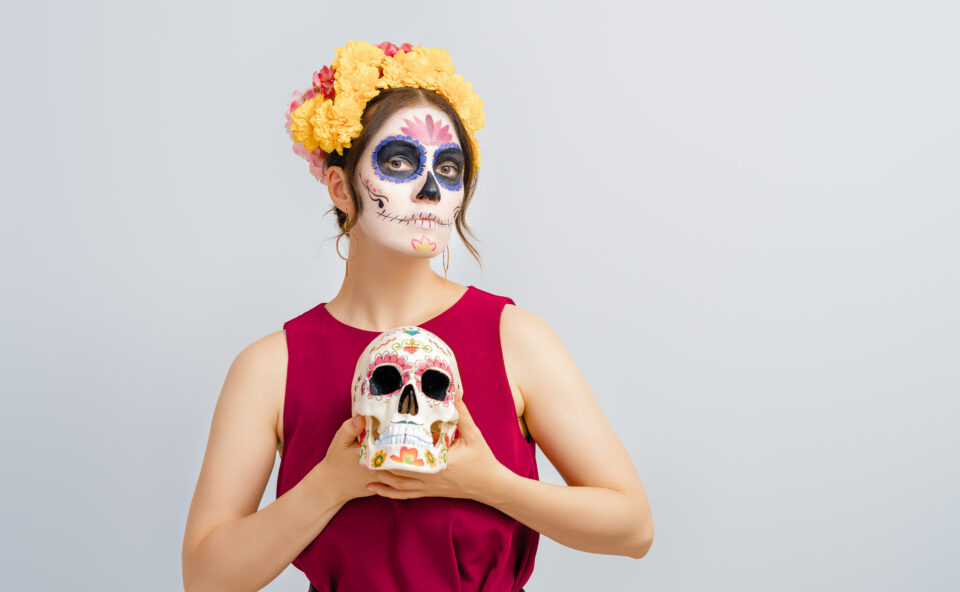Day of the Dead, or Día de Muertos, is one of the most important celebrations in Mexico. Its origins date back thousands of years, derived from the Aztec, Toltec, and other Nahua people. They saw death as an integral, ever-present part of life, and believed mourning the dead to be disrespectful.
Nowadays, the tradition is a blend of Mesoamerican rituals, Catholic religion, and Spanish culture. It’s based on the belief that, on the Day of the Dead, the border between the spirit world and the real world dissolves, meaning people can reunite with loved ones. It’s widely celebrated in Mexico, where parties and parades take place, and revellers don costumes, drink, dance, and play music.
History
Day of the Dead originated several thousand years ago with the Aztec, Toltec, and other Nahua people, who considered mourning the dead disrespectful. For these pre-Hispanic cultures, death was a natural phase in life’s long continuum. The dead were still members of the community, kept alive in memory and spirit—and during Día de Los Muertos, they temporarily returned to Earth.
When the Spaniards arrived in Mexico and introduced Catholicism to the indigenous people they blended traditions and beliefs to create their own customs.
Dia de Muertos came to be from a mixture of the Aztec festival dedicated to the goddess, Mictecacihuatl, with the Catholic influence. Mictecacihuatl is the “lady of the dead” and it is said that she watches over the bones of the dead and swallows the stars during the day.
The church rejected the Aztec’s beliefs and turned it into All Saints’ Day and All Souls’ Day making it 2 days to fall into the catholic calendar.
In 2008, UNESCO declared Día de Los Muertos an Intangible Cultural Heritage of Humanity, and in recent years it has transcended borders, becoming a cultural phenomenon enhanced by movies such as Pixar’s “Coco”.
Celebration
The annual holiday is celebrated on 1 and 2 November (All Saints’ Day and All Souls’ Day on the Catholic calendar). It is said that on November 1st the children who have passed come back to visit and celebrate as “angelitos” and on the following day, November 2nd, it’s the adults (Difuntos) turn to show up for the festivities.
Nov 1st – Dia de los Angelitos
Dia de Los Angelitos starts the holiday at midnight on Nov 1st when the spirits of all deceased children are believed to be reunited with their families for 24 hours. Families construct an altar, known as an ofrenda, with the departed child’s favourite snacks, candies, toys, and photographs to encourage a visit from their departed children. The names of the departed children will often be written on a sugar skull.
Nov 2nd (Morning)- Día de los Difuntos
At midnight of the following day (November 2nd), the celebrations shift to honour the lives of the departed adults. The night is filled with laughter and fun memories, much like the night before. However, the Ofrendas take on a more adult-like theme with tequila, pan de Muerto, mezcal, pulque, and jars of Atole. Families will also play games together, reminisce about their loved ones, and dance while the village band plays in their town.
Nov 2nd (Noon)- Día de los Muertos
The next day is the final and public celebration of Dia de Muertos. In more recent times, people come together in their cities, dressed up with Calavera painted faces (Skeletons), and have parades in the streets. Cemetery visits are also common on the last day as families will go to decorate the grave sites with Marigold flowers, gifts, and sugar skulls with the departed’s name on them. It’s customary to clean the gravestone and restore the colour.
Traditions
Altar
The centrepiece of the celebration is an altar, or ofrenda, built in private homes and cemeteries. These aren’t altars for worshipping; rather, they’re meant to welcome spirits back to the realm of the living. As such, they’re loaded with offerings—water to quench the thirst after the long journey, food, family photos, and a candle for each dead relative. If one of the spirits is a child, you might find small toys on the altar.
Every ofrenda includes items meant to correspond to the four elements: earth, water, air, and fire. Ashes or dirt typically stand in for earth, a glass of water, tissue paper carved with elaborate motifs is commonly used to represent air. Candles signify fire, helping guide the dead home.
Altars normally have multiple levels: Two levels symbolize the earth and the sky, three levels can represent heaven, earth, and purgatory, while seven levels signify the seven steps to enter the afterlife or the seven deadly sins.
Flor de Muerto
Marigolds are believed to be the pathways that guide the spirits to their ofrendas. The flower’s vibrant colours and scent attract the departed souls, as they return to feast on their favourite foods. They are called “Flor de Muerto” (Flower of Dead) and they symbolize the beauty and fragility of life. Marigold flowers include around 60 annuals and perennials that are native to Mexico and Central America.
Calaveras
Calaveras are ubiquitous during the Day of the Dead, especially the Calavera Catrina. The skulls are often drawn with a smile as to laugh at death itself. They take many forms such as sugar candies, clay decorations, and most memorable: face painting. Sugar skulls are decorated and placed on ofrendas of loved ones. A Calavera, or sugar skull, is a decorative skull made by hand from either sugar or clay which is used in the Mexican celebration of the Day of the Dead.

